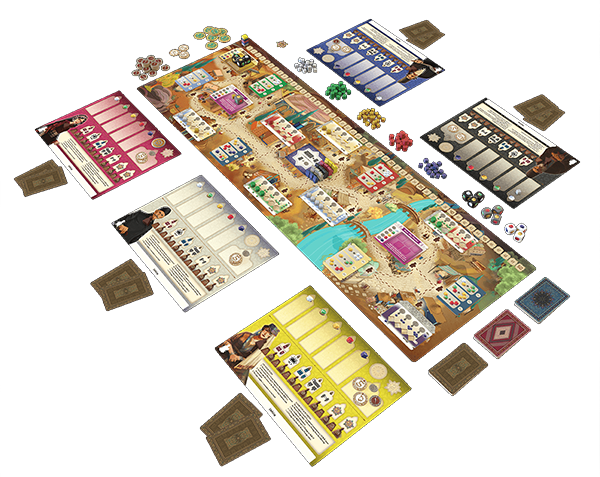Preview: Weave Your Way to Fame in Tabriz

This wonderfully elegant and engaging engine-building game from Spiel Des Jahres designer Randy Flynn (Cascadia) builds upon his growing reputation, as players compete to become the most famous carpet weaver.
Gameplay
The heart and soul of Tabriz unfolds in the central bazaar of the titular Persian city that is represented by the long playmat, which acts as the game’s board. This is where the stalls will be laid out, full of the dyes and materials necessary. Players will also have their own player board, where goods will be managed and upgrades to abilities on the skill track, as well as Workshop bonuses, will be stored.
Players will begin with two Labor commission cards after initially being dealt four. These commission cards will be what players are trying to fulfill to gain the rewards and upgrades printed on the cards. As players move around the bazaar with their three assistants (being able to move one up to three spaces per turn), they will choose one and move them following the adjacent footsteps to one of the stalls and completing that action.
Stalls offer the opportunity for players to gain the necessary resources to complete their commissions. Completing commissions is important, not only for earning the money necessary to buy more resources to complete further commissions, but also in gaining player upgrades and bonuses that will help players during the Workshop (end of round) phase.
Once the action is completed, players will lay that assistant down. If players are able to complete one of their commission cards, they may also do this on their turn. The next player will take their turn, going clockwise around the table. Once each player has moved all three assistants, the round will end. The stalls will refill their goods based on what each location card shows. If refilling resources causes leftover stock at stalls with an ‘x’, all resources may be removed from that stall (some stalls with an ‘x’ also have exceptions that require at least one good be available at all times). Players will also collect any Workshop bonuses from completed commissions they have tucked under their player boards, such as money and resources. Assistants are placed standing up, and play resumes.
As players fulfill commissions and earn upgraded abilities, better commissions will become available to them through Merchant and Aristocrat commission decks. Commission cards are available by visiting the central market stall. Other stalls offer resources or the ability to swap a predetermined amount of one type of resource for a set number of another resource.
Play continues until a player completes their ninth commission or reaches 14 points. This player will gain the 2-point prestige token that will factor into the final tally. The round finishes, with players calculating their point totals from completed commissions and upgraded abilities on the skill track with the highest total declared the winner.

Review
If we’ve learned anything from Cascadia, it’s that Randy Flynn is great at taking simple mechanics and layering in crunchy thought for an easy-to-learn, but hard-to-master gaming experience. Tabriz is no different, and in fact wratchets up this formula without a steep increase to accessibility.
Tabriz will have fans of Century: Spice Road salivating, as it takes some of its cues from the elegant simplicity of that game but makes the engine building more thoughtful, turns more meaningful, and actions more rewarding. Don’t misunderstand: Tabriz is not a knock-off, an evolution, or a continuation of that game. But it will scratch a similar itch, same as it will for fans of Flynn’s Cascadia.
Yet, where Tabriz shines is in the variability of its board. The stalls have predetermined areas based on their shapes, but where they are placed and which side is face-up is up to the luck of the deal. This means that the travel patterns and strategic maneuvering will change with each play. This is crucial to Tabriz’s longevity in one’s collection.
What really helps Tabriz stand out is the art of Syd Fini, as well as the cultural collaborators Crafty Games brought on to make Tabriz’s history shine throughout the gameplay. Often, games that portray both a place and time do so with a thin veneer of art and little else, but with Tabriz there is more authenticity to the actions of this lively bazaar and the art style that brings it all together.
Other than some analysis paralysis that may occur with certain players, Tabriz provides a happy medium between casual gamers looking for a fun engine-building experience while also providing a game with a bit more depth thanks to bonuses gained during the Workshop phases as well as each player’s skill track. Players can choose to really make themselves wring every bit of ability out of focusing on this track, while others may choose a stripped-down engine in a race to quickly complete nine commissions before someone can upgrade into a powerful player. Finding the balance with each game is based on how the market board bears out.
Tabriz is both beautiful in design and gameplay, and its willingness to be both a fun board game and piece of living history is commendable. Though some games can extend past the 45-minute playtime if players decide to weigh every decision and wring out every last bit of choice the game has to offer, most of the time it’ll be 45 minutes well spent around a table with friends (or by oneself) engaged in an uplifting puzzle of engine-building brilliance.
Crafty Games is currently running a crowdfunding campaign for Tabriz on Gamefound.
Pros: Fantastic art and historical direction, Interesting and rewarding choices on each turn of the game
Cons: Players with analysis paralysis may slow down the flow of the game




